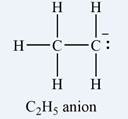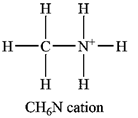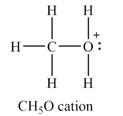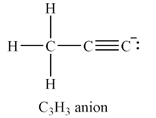
Concept explainers
(a)
Interpretation:
The Lewis structure of the
Concept introduction:
Lewis structure of a molecule or ion is drawn considering only the valence electrons of the atoms. In case of ions, for each negative charge an electron is added while for each positive charge an electron is subtracted on the ion. Each bond shows a shared pair of electrons. Single, double, and triple bonds are represented by one, two, and three lines, respectively, connecting the two atoms. Non-bonding electrons are shown as dots, generally as lone pairs. Atoms in a Lewis structure should not exceed their valency. The atoms from the 2nd row must not exceed an octet of valence electrons. Atoms from the 3rd row onward may exceed an octet by up to four electrons if they are central atoms.
The formal charge (FC) on an atom is determined as the difference between its group number and the actual number of electrons it possesses in the molecule or ion. The formula to calculate formal charge is as below.
Answer to Problem 1.50P
The Lewis structure of the

The atom that bears a non-zero formal charge is the carbon atom on the right, bonded to only two hydrogens.
Explanation of Solution
The total of valence electrons based on the formula

The formal charge on each hydrogen atom is zero:
The formal charge on the first carbon (on the left) is zero:
The formal charge on the second carbon is
Therefore, it is the carbon atom on the right, bearing only two hydrogen atoms, that has a non-zero formal charge.
The formal charge on an atom is the difference in its group number and the actual number of electrons it possesses in the molecule or ion.
(b)
Interpretation:
The Lewis structure of the
Concept introduction:
Lewis structure of a molecule or ion is drawn considering only the valence electrons of the atoms. Each bond shows a shared pair of electrons. Single, double, and triple bonds are represented by one, two, and three lines, respectively, connecting the two atoms. Non-bonding electrons are shown as dots, generally as lone pairs. Atoms in a Lewis structure should not exceed their valency. The atoms from the 2nd row must not exceed an octet of valence electrons. Atoms from the 3rd row onward may exceed an octet by up to four electrons if they are central atoms.
The formal charge on an atom is determined as the difference between its group number and the actual number of electrons it possesses in the molecule or ion. The formula to calculate formal charge is as below.
Answer to Problem 1.50P
The Lewis structure of the

The carbon atom is the one that has a non-zero formal charge.
Explanation of Solution
Carbon is the central atom in this cation, with two hydrogen atoms and the oxygen atom bonded to it. The third hydrogen atom is bonded to the oxygen as shown below:

The formal charges on the atoms are calculated as below:
Hydrogen atoms:
Carbon atom:
Oxygen atom:
An alternate structure can be drawn with all three hydrogen atoms and the oxygen atom bonded to the central carbon. However, this will put the positive charge on a highly electronegative oxygen, making it unstable. Therefore, the above mentioned structure is the most likely structure.
Therefore, the carbon atom has a non-zero formal charge.
The formal charge on an atom is the difference in its group number and the actual number of electrons it possesses in the molecule or ion.
(c)
Interpretation:
The Lewis structure of the
Concept introduction:
Lewis structure of a molecule or ion is drawn considering only the valence electrons of the atoms. Each bond shows a shared pair of electrons. Single, double, and triple bonds are represented by one, two, and three lines, respectively, connecting the two atoms. Non-bonding electrons are shown as dots, generally as lone pairs. Atoms in a Lewis structure should not exceed their valency. The atoms from the 2nd row must not exceed an octet of valence electrons. Atoms from the 3rd row onward may exceed an octet by up to four electrons if they are central atoms.
The formal charge on an atom is determined as the difference between its group number and the actual number of electrons it possesses in the molecule or ion. The formula to calculate formal charge is as below.
Answer to Problem 1.50P
The Lewis structure of the

The atom with a non-zero formal charge is the nitrogen.
Explanation of Solution
Carbon usually forms four bonds; therefore, it is a central atom. Three of the hydrogen atoms and the nitrogen atom must be bonded to it. The nitrogen atom in turn is also a central atom, with the remaining three hydrogen atoms bonded to it. Normally nitrogen forms only three bonds, but it can use its lone pair to form another bond, generally to a hydrogen ion. Therefore, the Lewis structure of the cation must be

The formal charges on the atoms are calculated as follows:
Hydrogen atoms:
Carbon atom:
Nitrogen atom:
Therefore, it is the nitrogen atom that has a non-zero formal charge.
The formal charge on an atom is the difference in its group number and the actual number of electrons it possesses in the molecule or ion.
(d)
Interpretation:
The Lewis structure of the
Concept introduction:
Lewis structure of a molecule or ion is drawn considering only the valence electrons of the atoms. Each bond shows a shared pair of electrons. Single, double, and triple bonds are represented by one, two, and three lines, respectively, connecting the two atoms. Non-bonding electrons are shown as dots, generally as lone pairs. Atoms in a Lewis structure should not exceed their valency. The atoms from the 2nd row must not exceed an octet of valence electrons. Atoms from the 3rd row onward may exceed an octet by up to four electrons if they are central atoms.
The formal charge on an atom is determined as the difference between its group number and the actual number of electrons it possesses in the molecule or ion. The formula to calculate formal charge is as below.
Answer to Problem 1.50P
The Lewis structure of

The atom with non-zero formal charge is the oxygen atom.
Explanation of Solution
The

The formal charges on the atoms are calculated as follows:
Hydrogen atoms:
Carbon atom:
Oxygen atom:
Therefore, the oxygen has a non-zero formal charge.
The formal charge on an atom is the difference in its group number and the actual number of electrons it possesses in the molecule or ion.
(e)
Interpretation:
The Lewis structure of the
Concept introduction:
Lewis structure of a molecule or ion is drawn considering only the valence electrons of the atoms. Each bond shows a shared pair of electrons. Single, double, and triple bonds are represented by one, two, and three lines, respectively, connecting the two atoms. Non-bonding electrons are shown as dots, generally as lone pairs. Atoms in a Lewis structure should not exceed their valency. The atoms from the 2nd row must not exceed an octet of valence electrons. Atoms from the 3rd row onward may exceed an octet by up to four electrons if they are central atoms.
The formal charge on an atom is determined as the difference between its group number and the actual number of electrons it possesses in the molecule or ion. The formula to calculate formal charge is as below.
Answer to Problem 1.50P
The Lewis structure of the

The carbon atom at the right end of the chain has a non-zero formal charge.
Explanation of Solution
The total of the valence electrons for this anion is
The carbon atoms have capacity to form up to four bonds. If all three hydrogen atoms are on the same carbon, this carbon must be at the end of a chain of three carbon atoms. The other two carbon atoms must be triply bonded to each other in order to complete their octets. The carbon atom at the other end of the chain must have a lone pair so that all the valence electrons are accounted for.
The Lewis structure of the

The formal charges on the atoms are calculated as follows:
Hydrogen atoms:
Carbon atom on the left and in the center of the chain:
Carbon atom at the right end of the chain:
Therefore, it is the carbon atom at the right end of the chain that has a non-zero formal charge.
The formal charge on an atom is the difference in its group number and the actual number of electrons it possesses in the molecule or ion.
Want to see more full solutions like this?
Chapter 1 Solutions
Organic Chemistry: Principles And Mechanisms
- Predict the product of this organic reaction: IZ + HO i P+H₂O Specifically, in the drawing area below draw the skeletal ("line") structure of P. If there is no reasonable possibility for P, check the No answer box under the drawing area. No Answer Click and drag to start drawing a structure. ☐ :arrow_forwardPredict the products of this organic reaction: 0 O ----- A + KOH ? CH3-CH2-C-O-CH2-C-CH3 Specifically, in the drawing area below draw the condensed structure of the product, or products, of this reaction. (If there's more than one product, draw them in any arrangement you like, so long as they aren't touching.) If there aren't any products because this reaction won't happen, check the No reaction box under the drawing area. No reaction Click anywhere to draw the first atom of your structure. X ⑤ èarrow_forwardPredict the products of this organic reaction: O CH3 + H2O + HCI A A? CH3-CH2-C-N-CH3 Specifically, in the drawing area below draw the condensed structure of the product, or products, of this reaction. If there's more than one product, draw them in any arrangement you like, so long as they aren't touching. If there aren't any products because this reaction won't happen, check the No reaction box under the drawing area. No Reaction Click anywhere to draw the first atom of your structure.arrow_forward
- What is the missing reactant in this organic reaction? R+ HO-C-CH2-CH3 0= CH3 CH3 —CH, C−NH—CH CH3 + H₂O Specifically, in the drawing area below draw the condensed structure of R. If there is more than one reasonable answer, you can draw any one of them. If there is no reasonable answer, check the No answer box under the drawing area. Note for advanced students: you may assume no products other than those shown above are formed. No Answer Click anywhere to draw the first atom of your structure. €arrow_forward个 CHEM&131 9267 - $25 - Intro to Mail - Hutchison, Allison (Student x Aktiv Learnin https://app.aktiv.com Draw the product of the reaction shown below. Ignore inorganic byproducts. + Na2Cr2O7 Acetone, H2SO4 Type here to search Dryng OH W Prarrow_forwardPredict the products of this organic reaction: OH + NaOH A? Specifically, in the drawing area below draw the skeletal ("line") structure of the product, or products, of this reaction. (If there's more than one product, draw them in any arrangement you like, so long as they aren't touching.) If there aren't any products because this reaction won't happen, check the No reaction box under the drawing area. No reaction Click and drag to start drawing a structure. ✓ Sarrow_forward
- Predict the products of this organic reaction: CH3-C-O-CH2-CH2-C-CH3 + H₂O ? A Specifically, in the drawing area below draw the condensed structure of the product, or products, of this reaction. (If there's more than one product, draw them in any arrangement you like, so long as they aren't touching.) If there aren't any products because this reaction won't happen, check the No reaction box under the drawing area. No reaction Click anywhere to draw the first atom of your structure. :☐ darrow_forwardDE d. Draw an arrow pushing mechanism for the following IN O CI N fo 人 P Polle DELL prt sc home end ins F5 F6 F7 F8 F9 F10 F11 F12arrow_forwardPredict the products of this organic reaction: + H₂O H* ? A Specifically, in the drawing area below draw the skeletal ("line") structure of the product, or products, of this reaction. (If there's more than one product, draw them in any arrangement you like, so long as they aren't touching.) If there aren't any products because this reaction won't happen, check the No reaction box under the drawing area. No Reaction Click and drag to start drawing a structure.arrow_forward
- Predict the major organic products of the reaction below and draw them on right side of the arrow. If there will be no significant reaction, check the box below the drawing area instead. C Cl CH, OH There will be no significant reaction. + pyridine G Click and drag to start drawing a structure.arrow_forwardWhat is the missing reactant in this organic reaction? H R+ H2O Δ OH 0= CH3-CH-O-CH3 + CH3-C-OH Specifically, in the drawing area below draw the condensed structure of R. If there is more than one reasonable answer, you can draw any one of them. If there is no reasonable answer, check the No answer box under the drawing area. No Answer Click anywhere to draw the first atom of your structure. dyarrow_forwardYou are trying to determine whether the following organic reaction can be done in a single synthesis step. If so, add any missing reagents or conditions in the drawing area below. If it isn't possible to do this reaction in a single synthesis step, check the box below the drawing area instead. Note for advanced students: if you have a choice of reagents to add, you should choose the least reactive and most economical reagents possible. Cl It isn't possible to do this reaction in a single synthesis step. + T OHarrow_forward
 ChemistryChemistryISBN:9781305957404Author:Steven S. Zumdahl, Susan A. Zumdahl, Donald J. DeCostePublisher:Cengage Learning
ChemistryChemistryISBN:9781305957404Author:Steven S. Zumdahl, Susan A. Zumdahl, Donald J. DeCostePublisher:Cengage Learning ChemistryChemistryISBN:9781259911156Author:Raymond Chang Dr., Jason Overby ProfessorPublisher:McGraw-Hill Education
ChemistryChemistryISBN:9781259911156Author:Raymond Chang Dr., Jason Overby ProfessorPublisher:McGraw-Hill Education Principles of Instrumental AnalysisChemistryISBN:9781305577213Author:Douglas A. Skoog, F. James Holler, Stanley R. CrouchPublisher:Cengage Learning
Principles of Instrumental AnalysisChemistryISBN:9781305577213Author:Douglas A. Skoog, F. James Holler, Stanley R. CrouchPublisher:Cengage Learning Organic ChemistryChemistryISBN:9780078021558Author:Janice Gorzynski Smith Dr.Publisher:McGraw-Hill Education
Organic ChemistryChemistryISBN:9780078021558Author:Janice Gorzynski Smith Dr.Publisher:McGraw-Hill Education Chemistry: Principles and ReactionsChemistryISBN:9781305079373Author:William L. Masterton, Cecile N. HurleyPublisher:Cengage Learning
Chemistry: Principles and ReactionsChemistryISBN:9781305079373Author:William L. Masterton, Cecile N. HurleyPublisher:Cengage Learning Elementary Principles of Chemical Processes, Bind...ChemistryISBN:9781118431221Author:Richard M. Felder, Ronald W. Rousseau, Lisa G. BullardPublisher:WILEY
Elementary Principles of Chemical Processes, Bind...ChemistryISBN:9781118431221Author:Richard M. Felder, Ronald W. Rousseau, Lisa G. BullardPublisher:WILEY





